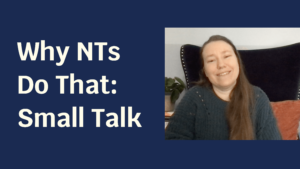Not a lost cause
Social stuff is right up there with sensory issues as the most challenging parts of autism. But it’s not a lost cause. Social skills can be learned. Yes, even by autistic people.
But here’s the catch. Social skills aren’t often taught to us autistics in the way that autistics learn them. That’s part of why most social skills trainings and therapies don’t work.
If someone tries to teach a blind person by giving them a printed book, and then tests them on how well they learned, the test is going to show abysmal results. And if you give autistic people social skills training in a way that is inaccessible to them, and then test us on our social skills, of course we are going to repeatedly fail. That’s not a problem with our innate ability to learn, it is a problem with how the material is presented.
This is precisely why autistic adults are an invaluable resource in conversations around autistic therapies. We have the insider perspective. We can tell you what works and what doesn’t.
What does work?
Conventional therapies label pictures of people as “angry” or “excited,” and focus on how to react. But as a kid, you could have showed me a hundred pictures of angry people, and I wouldn’t have been able to say when the person next to me was angry — probably angry at me by that point.
Because I didn’t have an intuitive sense of what information in those pictures, or faces, was relevant, and what meaning to assign it. Am I supposed to be able to tell the person is angry because their shirt is red? Should I be looking at the background? Or at their ears? Is it something to do with their nose? I’m making this a little ridiculous to highlight my point, but that is essentially what is going on.
What autistic children need are pictures of people, or live people, combined with explicit descriptions of what body language to look for, explanations of what these nonverbal cues are intended to express, and modeling the thought process used to reach conclusions.
This looks like: “Look at this woman. Her eyes are narrow, her jaw is tight, her hands are clenched, and she’s talking really loudly at her phone. People can talk loudly for a number of different reasons. A tight jaw is always a sign of some negative emotion, but it could be anger, or anxiety, or even background stress that has nothing to do with the situation. But the clenched hands and narrowed eyes together are a giveaway. Combined with the others, they are always a sign of anger.”
Why this doesn’t happen
Aww, it’s like I can hear you scoffing at the computer right now, going “Seriously? That’s what you want me to do with my kid? Describe every social encounter in excruciating detail?”
Seriously, that would be wonderful. But realistically, that’s probably not gonna happen. That’s why you hire me! 🙂
Autistic adults fill online forums and message boards with this kind of talk. And those real life moments when someone gifts us with a direct explanation of some social situation are some of the highlights of our lives.
The biggest reason why autistic therapies generally don’t do this is because non-autistic people generally don’t know how to do this. You probably learned to read body language intuitively when you were so young you can’t even remember doing so.
I used to be really frustrated with the phrase “if you don’t know why I’m mad, I can’t tell you.” But I’ve come to understand that, while it is said in exasperation, it is the truth.
Very few people would be able to analyze how they know that woman on the cell phone is angry, beyond just saying, “look at her, she’s obviously angry.” If pressed, they might point out her loud voice, but it’s more likely they would describe the tone of her voice. But since some autistic people don’t pick up on tone, that’s still not helpful.
Natural learning
The other issue with how social skills are usually taught, is that doing this as part of a program of things that have to be covered in a particular order isn’t useful because it doesn’t relate to your kid’s life right now.
Everyone learns best when what they’re learning is useful to them personally at the time.
Instead of a program, I want your kid to tell me about a recent social situation that was confusing for him and that he wants explained, and then we will talk about it and discuss what happened, and why that happened, and what the other person intended by what they said, and how they can tell, and other possible ways they could respond in the future.
This will take time. It’s not an overnight fix, but nothing with autism is an overnight fix. You know that already. But it’s working on the skills that are actually needed, in a way that they can learn, and so there will actually be progress. As the skills are practiced, and the underlying lessons are absorbed, the rate of progress will increase.




